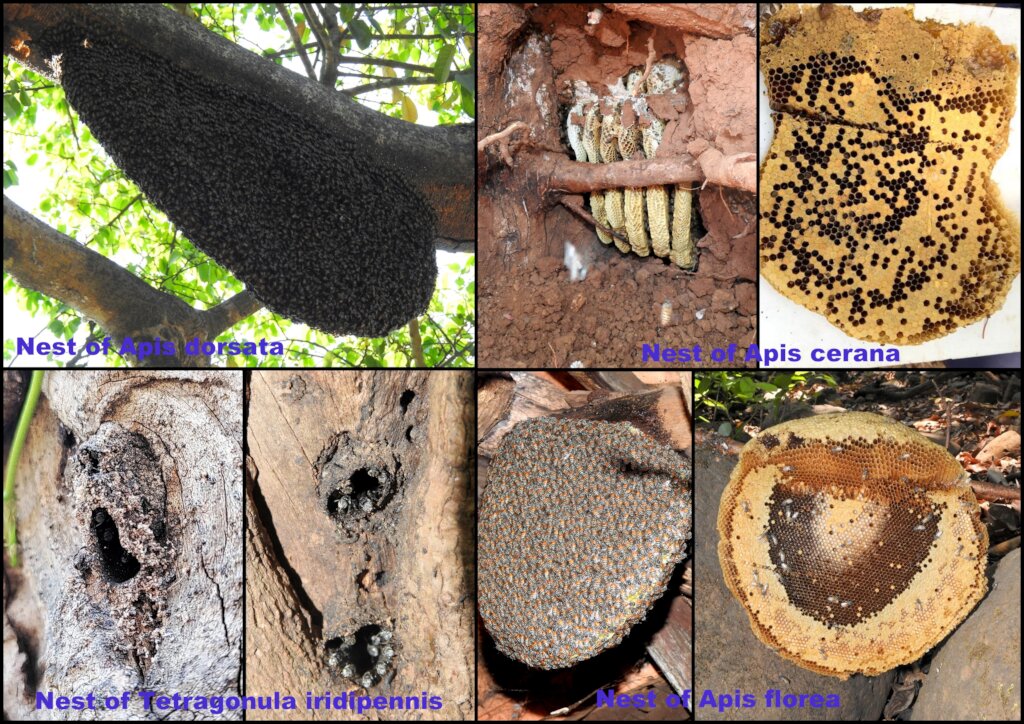By Akshay Varsha Gawade | Project Leader
Amid the lush and vibrant landscapes of the Western Ghats, a captivating narrative of nature's architectural prowess unfolds. Four distinct species of honey bees - the Asian honey bee (Apis cerana), the Giant honey bee (Apis dorsata), the Dwarf honey bee (Apis florea), and the Indian stingless bee (Tetragonula iridipennis) - engage in the construction of their intricate nests. Each bee species showcases a unique and ingenious approach to nest building, a testament to the evolution of their behaviours and adaptations over time.
The Giant Honey Bee (Apis dorsata)
In the lofty treetops, the Giant honey bee, Apis dorsata, adopts a distinct strategy. Their nests are nothing short of breath-taking, suspended like colossal teardrop-shaped chandeliers from tree branches. These grand hives can exceed a meter in length. Apis dorsata constructs their nests from a blend of wax and plant fibbers, resulting in a distinctive, coarse appearance. While these exposed nests offer exceptional ventilation, they remain vulnerable to the elements. Yet, the giant bees employ meticulous coordination, forming layers on the surface to safeguard against the harshness of heat and rain. Their nests stand as a testament to the power of cooperation and precise thermoregulation.
The Dwarf Honey Bee (Apis florea)
As its name implies, the Dwarf honey bee is the smallest among honey bee species. These bees favour concealed and sheltered locations, such as tree branches, rock crevices, and occasionally even human dwellings. Their hives are typically open-nesting structures with a single comb on a single branch. When constructing a new nest near an existing one, they recycle wax from the old nest, behaviour not commonly observed in other honeybee species, possibly due to concerns about pathogen contamination.
The Indian Stingless Bee (Tetragonula iridipennis)
Nestled in the heart of India's tropical regions, Tetragonula iridipennis, the Indian stingless bee, weaves its unique abode. Despite lacking stingers, these bees are experts in nest construction. They select hollow cavities like tree trunks or crevices in rocks for their nests. What sets Tetragonula iridipennis apart is its use of resin and wax in constructing complex, spiral-shaped combs with narrow and winding entrances, fortifying their nests against potential predators. These stingless bees exhibit a sophisticated social structure and play a pivotal role in pollination.
The Asian Honey Bee (Apis cerana)
In stark contrast to its fellow honey bee species, the Asian honey bee, Apis cerana, follows a different path in nest construction. Adapting to the circumstances, this bee species chooses to establish its nests underground, reducing competition for ground-level nest sites. These diligent bees favour concealed and sheltered locations like holes in the soil, crevices in rocks, or hollow tree trunks. Their nests consist of multiple vertically arranged combs with hexagonal cells fashioned from wax. This underground strategy helps regulate temperature and shields the colony from natural adversities. The queen occupies the central chamber, surrounded by worker bees, while a compact, waterproof covering safeguards the outer layer of the comb, preserving their precious stores of nectar and pollen. The Asian honey bee's underground nests are celebrated for their efficiency and their capacity to thrive in diverse environments.
By Akshay Varsha Gawade | Project Leader
By Akshay Gawade | Project leader
Project reports on GlobalGiving are posted directly to globalgiving.org by Project Leaders as they are completed, generally every 3-4 months. To protect the integrity of these documents, GlobalGiving does not alter them; therefore you may find some language or formatting issues.
If you donate to this project or have donated to this project, you can receive an email when this project posts a report. You can also subscribe for reports without donating.
Support this important cause by creating a personalized fundraising page.
Start a Fundraiser